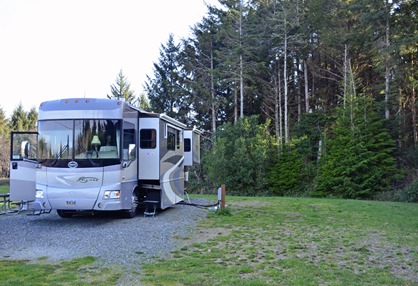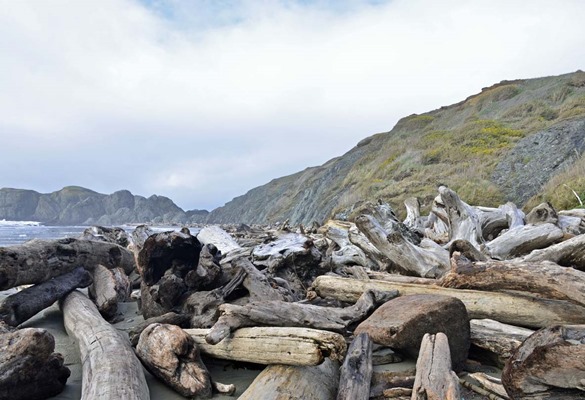When we decided to retire to a motor home, we knew we wanted to do something other than just travel, spend time in RV parks, and visit attractions. Both Brenda and I were always interested in learning more about wildlife, birds, and history, but work, family, and life in general never gave us the time. And so we decided to give volunteering at try.
We started by searching volunteer.gov, where every federal and some state volunteer positions are advertised. We settled on searching for openings with US Fish & Wildlife, and sent off applications to the few that interested us.
 One day, while out shopping, we received a call from the volunteer coordinator at Lee Metcalf NWR in Stevensville, Montana asking us if we were interested in spending the summer there. We’d be the first “resident” volunteers to stay on their new RV pads, so it was a first for both of us. We accepted, and that April 2006 was the beginning of a journey that has far exceeded our hopes and dreams of full-time RVing.
One day, while out shopping, we received a call from the volunteer coordinator at Lee Metcalf NWR in Stevensville, Montana asking us if we were interested in spending the summer there. We’d be the first “resident” volunteers to stay on their new RV pads, so it was a first for both of us. We accepted, and that April 2006 was the beginning of a journey that has far exceeded our hopes and dreams of full-time RVing.  We look back now and are so grateful that we were lucky enough to fall into Lee Metcalf NWR as our first experience. The staff was welcoming, the area was incredibly beautiful, the wildlife was spectacular, and most of all we were encouraged to explore and learn. We laugh now looking back – we were given a set of keys to the visitor center and told “You guys are it on the weekends”, and knowing we’d be asked questions about the many birds and waterfowl on the refuge, spent hours poring through Sibley Birding Guides and quizzing each other. It wasn’t long before we realized that we were having fun learning – and enjoying being able to share our newfound knowledge. Within a month, we were comfortable in explaining wildlife to visitors, helping teach children’s environmental education, and leading tours.
We look back now and are so grateful that we were lucky enough to fall into Lee Metcalf NWR as our first experience. The staff was welcoming, the area was incredibly beautiful, the wildlife was spectacular, and most of all we were encouraged to explore and learn. We laugh now looking back – we were given a set of keys to the visitor center and told “You guys are it on the weekends”, and knowing we’d be asked questions about the many birds and waterfowl on the refuge, spent hours poring through Sibley Birding Guides and quizzing each other. It wasn’t long before we realized that we were having fun learning – and enjoying being able to share our newfound knowledge. Within a month, we were comfortable in explaining wildlife to visitors, helping teach children’s environmental education, and leading tours. Spending a summer in the Bitterroot Valley gave us an opportunity to explore some of the country that is billed as “the last best place”. Brenda saw her first moose, I caught cutthroat trout in remote mountain streams, and we made lifetime friends that we still visit every year.
 Since that experience we’ve volunteered at other US Fish & Wildlife locations, Oregon and Washington State Parks, The Nature Conservancy, and the Bureau of Land Management. With very few exceptions, we’ve been welcomed, appreciated, and best of all, educated in a new facet of nature. We’ve become proficient “birders”, versed in the history of the fisheries of the Western US, and amateur naturalists. We’ve led wildlife and nature walks, given evening programs on Seals and Sea Lions, and guided people at Pacific tide pools.
Since that experience we’ve volunteered at other US Fish & Wildlife locations, Oregon and Washington State Parks, The Nature Conservancy, and the Bureau of Land Management. With very few exceptions, we’ve been welcomed, appreciated, and best of all, educated in a new facet of nature. We’ve become proficient “birders”, versed in the history of the fisheries of the Western US, and amateur naturalists. We’ve led wildlife and nature walks, given evening programs on Seals and Sea Lions, and guided people at Pacific tide pools.  But most of all, we’ve had the opportunity to teach children about the wonders of nature as “Junior Ranger” program hosts. We look back to our first volunteer job, where Bob, our boss and mentor once said “we’re raising a generation of flat screen children, and if we don’t get them involved in nature, we’ll loose our parks and refuges”.
But most of all, we’ve had the opportunity to teach children about the wonders of nature as “Junior Ranger” program hosts. We look back to our first volunteer job, where Bob, our boss and mentor once said “we’re raising a generation of flat screen children, and if we don’t get them involved in nature, we’ll loose our parks and refuges”. 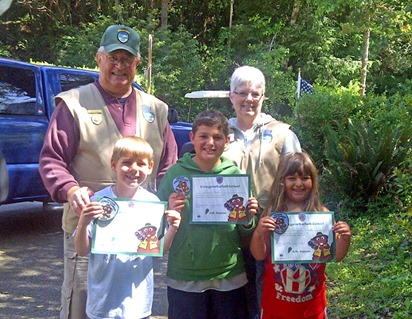 We’ve taken those words to heart, and whenever possible concentrate on getting children engaged and interested. We’ve found that even disinterested young teens will drop the attitude of “what-ever”, and become interested if you present nature in an interesting way.
We’ve taken those words to heart, and whenever possible concentrate on getting children engaged and interested. We’ve found that even disinterested young teens will drop the attitude of “what-ever”, and become interested if you present nature in an interesting way.  After a few years, we decided that we’d focus on “interpretive” hosting only, although we’ve done a bit of maintenance here and there. In the volunteer world, “interpretive hosting” is understood as the means to explain nature and wildlife in terms that are interesting, easy to understand, and relevant to the audience. It’s often confusing to campers, like the lady that knocked on our door with a letter written in Spanish and wanted us to translate it for her. We explained that we couldn’t do that, and she pointed to our sign; “but it says you’re interpretive hosts”.
After a few years, we decided that we’d focus on “interpretive” hosting only, although we’ve done a bit of maintenance here and there. In the volunteer world, “interpretive hosting” is understood as the means to explain nature and wildlife in terms that are interesting, easy to understand, and relevant to the audience. It’s often confusing to campers, like the lady that knocked on our door with a letter written in Spanish and wanted us to translate it for her. We explained that we couldn’t do that, and she pointed to our sign; “but it says you’re interpretive hosts”. 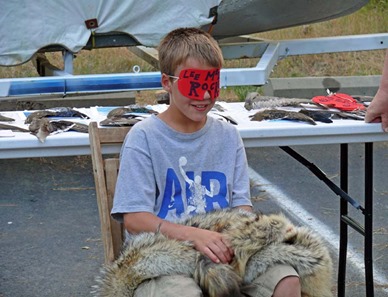 Teaching children has given us so many great memories. Like the French children whose mother was frustrated because they wouldn’t remove their beaded , salamander necklaces that they made at a Junior Ranger class – even to sleep or shower.
Teaching children has given us so many great memories. Like the French children whose mother was frustrated because they wouldn’t remove their beaded , salamander necklaces that they made at a Junior Ranger class – even to sleep or shower.  Or the little boy, who after being issued his Junior Ranger badge and taught the “secret” sign, ran to his grandfather yelling, “grandpa, grandpa!” “I learned the secret sign!”…..”I’ll show it to you for five bucks!” But most of all, the mother of a learning-disabled child who broke down in tears telling us that he had recited everything we’d taught him about hummingbirds – something he’d never done before.
Or the little boy, who after being issued his Junior Ranger badge and taught the “secret” sign, ran to his grandfather yelling, “grandpa, grandpa!” “I learned the secret sign!”…..”I’ll show it to you for five bucks!” But most of all, the mother of a learning-disabled child who broke down in tears telling us that he had recited everything we’d taught him about hummingbirds – something he’d never done before.  Besides the enjoyment we get from sharing our knowledge, there are other advantages to volunteering. As part of the volunteer agreement, we’re given a free site with full hookups, and sometimes other perks such as a phone line or washer/dryer access. Most of the sites are superior to the camping sites, and some, like at refuges, are spacious and away from the crowd.
Besides the enjoyment we get from sharing our knowledge, there are other advantages to volunteering. As part of the volunteer agreement, we’re given a free site with full hookups, and sometimes other perks such as a phone line or washer/dryer access. Most of the sites are superior to the camping sites, and some, like at refuges, are spacious and away from the crowd. Spending three months or so in an area also gives us a chance to explore. We choose volunteer sites based on the location; places we’re interested in spending time exploring and learning about. The Bitterroot Valley of Montana, surrounded by the Bitterroot and Sapphire Mountains was like nothing we’d ever seen, and our stay gave us the
Spending three months or so in an area also gives us a chance to explore. We choose volunteer sites based on the location; places we’re interested in spending time exploring and learning about. The Bitterroot Valley of Montana, surrounded by the Bitterroot and Sapphire Mountains was like nothing we’d ever seen, and our stay gave us the  chance to visit the Big Hole valley and battlefield, Glacier National Park, and follow the route of Lewis and Clark. Our time in Spearfish, SD gave us the chance to follow Custer’s route through the black hills, travel the Needles Highway, see Mount Rushmore, D
chance to visit the Big Hole valley and battlefield, Glacier National Park, and follow the route of Lewis and Clark. Our time in Spearfish, SD gave us the chance to follow Custer’s route through the black hills, travel the Needles Highway, see Mount Rushmore, D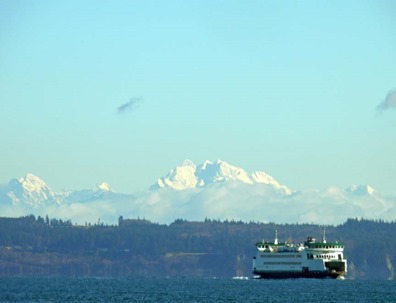 evil’s Tower, and get in some great trout fishing. The northern Washington coast was amazing for its view of the Olympic Mountains and the Straits of Juan de Fuca. We rode the ferry to Seattle and Whidbey Island, toured Forks and Twilight’s land of Vampires and Werewolves, and visited snow-covered
evil’s Tower, and get in some great trout fishing. The northern Washington coast was amazing for its view of the Olympic Mountains and the Straits of Juan de Fuca. We rode the ferry to Seattle and Whidbey Island, toured Forks and Twilight’s land of Vampires and Werewolves, and visited snow-covered  Mount Hood. But of all the great places we’ve been, we keep coming back to the Oregon Coast. The beauty of sea stacks and pounding surf, the amazing wildlife and the abundance of berries and seafood, and the temperate climate keep drawing us back. We still haven’t found the perfect place to settle down some day, but the Oregon Coast edges out Montana by just a bit so far. But there are more places to see….
Mount Hood. But of all the great places we’ve been, we keep coming back to the Oregon Coast. The beauty of sea stacks and pounding surf, the amazing wildlife and the abundance of berries and seafood, and the temperate climate keep drawing us back. We still haven’t found the perfect place to settle down some day, but the Oregon Coast edges out Montana by just a bit so far. But there are more places to see….An important part of our life that we hadn’t really considered was the joy of learning and understating the world around us. We’ve taught people about birds, raptors, and waterfowl, led wildlife and nature walks, explained the history of fisheries in the west, coastal defense of the Northwest, and lighthouse history; developed programs about seals and sea lions, and guided visitors at tide pools. All of this was new to us, and the challenge of learning new subjects at each location has been invigorating and we think, keeps us young at heart. This from a couple, who at retirement only knew birds as Robins and all others, ducks as Mallards and all others, and who thought all Seals and Sea Lions were the same.
And finally, we’ve made so many good friends – fellow volunteers, refuge and park staff, and visitors. We’ve found that we’re a part of a community wherever we go, and visit friends we made wherever we travel. We all have the same thing in common, we’re not competing with each other, and we all truly love what we do. What could be better than that?
We don’t have any plans to stop what we’re doing, and look forward to many more adventures. If you’re interested in joining us on the volunteer road, let us know, we'd be glad to help in any way.
